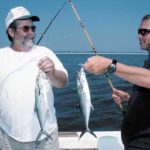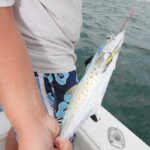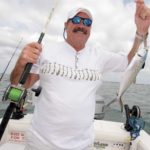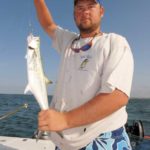
A Southport captain and his son land spring Spaniards with multiple-rig lures.
The air was heavy and hot as the inside of a Turkish steam bath, typical summer weather at Southport’s waterfront.
The only way to defend against copious sweating was to sit in air conditioning or blow-dry it away with a fast boat ride. Yet despite the summer weather, for some anglers, it was about to become Christmas.
Capt. Butch Foster was warming the engines of his 28-foot Mako boat, Yeah Right, when his anglers, Joe Liles and Jerry Blanchard, swapped the coolness of air-conditioned vehicles for a stifling walk along the dock. Rods were waving, greeting them from gunwale holders and a topside rod rack. Dangling from the rods were strings of red, orange, green and hot-pink tube lures, as well as strands of sparkly jigs with tinsel tails flashing silver and gold.
To the uninitiated, the boat appeared to be decorated for Christmas. An odd comment to that effect brought a surprising response.
“That’s just what they are,” Foster said. “Some fishermen call multiple-lure rigs we use for catching Spanish mackerel ‘Christmas tree’ rigs because of the way they’re strung together like Christmas lights and garlands.
“Christmas tree rigs have been through quite an evolution. Everyone seems to think they’re revolutionary because you can buy them anywhere. But they started out as soda-straw rigs a few years ago. Now they’ve become more sophisticated and accepted.
“Most tackle manufacturers offer at least one style for fishermen who use them to catch Spanish mackerel. You don’t have to make your own anymore.”
Many fishermen are familiar with Sabiki rigs, which are multiple-feather jigs rigged on a single leader. The tiny jig rigs are used to catch baitfish at offshore structure for a day of fishing for species such as king mackerel.
Christmas tree rigs, which are also called “squid rigs” or “mackerel rigs,” are similar to Sabiki rigs. But rigs targeting Spanish mackerel have heavier leaders and larger lures than the Sabikis anglers use for catching baitfish.
“The original Christmas tree rigs were made with soda straws threaded on the shanks of long-shank hooks,” Foster said. “Chris (Foster) and I tied a dropper in the leader every 18 inches or so, put a 3-inch piece of soda straw over the hook and tied the hook to the dropper.
“Soda straws come in a variety of colors and Spanish typically key in on a certain color. We’d rig several colors on the same leader until we saw what the fish were biting best.”
Chris Foster, a sometimes boat mate for his father, also has a captain’s license and said he’ like to become a charter captain once he finishes college.
“I liked the soda straw rigs,” he said. “But when they came out with the Christmas tree rigs, it made using them easier.
“You buy several packs of them, and when the hooks get bit off or the lures get worn out, all you have to do now is replace the entire rig. You don’t have to retie the rig with individual lures.”
The elder Foster said newer, factory-made rigs are easy to use and inexpensive, so most fishermen no longer use homemade soda straw rigs. He said every time he goes to the tackle shop or looks in a lure catalogue, it seems a company has developed a different style or model.
“I like tinsel lures and the tube lures because they’re so durable,” he said. “But most of Christmas tree rigs are tied on 30-pound-test monofilament leader so they can get cut off.
“If a big king or Spanish mackerel gets a good bite on the leader, that lure’s gone. If you get into a school of bluefish or bonito, you can lose the whole thing. You have to make sure you have a good supply of rigs before you head out.”
The Foster’s don’t use Christmas tree rigs exclusively. They said a Christmas tree rig is just another weapon in the arsenal against the finicky nature of Spanish mackerel.
“Spanish mackerel are one of the most aggravating fish you can catch,” Chris Foster said. “Most of the time, they bite willingly. But some days, they’re jumping everywhere and you can hardly get a strike. That’s when the multiple-hook rigs come in handy.
“They can offer lots of different sizes and colors at the same time. If you keep catching fish on a certain color, you’ll find it out fast enough to save a trip.”
Despite the fact there can be as many as six lures on a single Christmas tree rig, seldom do that many Spanish mackerel get hooked and landed at the same time. Fish strike, other fish follow and attack the remaining lures, but once hooked, the fish fight one another.
“It’s very common to catch two Spanish mackerel with one rig at the same time, but you’ll rarely catch three or more, no matter how many lures on the leader,” Chris Foster said. “They fight each other, pulling every which way and some of them always get off when there more than two are hooked.
“But there’s nothing wrong with bailing Spanish mackerel two at a time, as long as you you know what you’re doing.”
Bodie, the Fosters’ Pomeranian dog, is getting arthritic and doesn’t go with his masters during every fishing trip these days. But he still can spot Spanish mackerel from the bow of the boat when he’s onboard. The feisty little “fish dog” has learned to stay away from the extra hooks when a Spanish mackerel hit the deck thrashing.
“If a dog can learn to pick up a fish without getting hooked, any person can do it,” Butch Foster said. “You swing the entire rig out of the water by grabbing the leader ahead of the first lure and haul all the fish onto the deck. I use a rag to hold the fish while de-hooking them because they’re slippery. Then I just put the rig back in the water.”
Butch Foster said keeping lures clear of clothing and not standing on them was key to getting them back overboard safely. He once hooked himself by tossing the rig over while standing on it. Luckily, the Clarkspoon at the end of the rig hooked his arm; it was simple to lever the hook free by pressing down on the stiff lure. He said a softer tube lure might have required pliers to pull the lure free.
“There are several ways to fish Christmas tree rigs,” he said. “I usually use them with a bird or a trolling sinker.
“At the end of the rig is a Clarkspoon. The drag of the spoon keeps the line of lures trolling straight and also adds some vibration to make the lures attractive to fish.
“The trolling sinker keeps the leader tight and takes the lures below the surface, which is especially important after the first bite of the morning when the fish are deep or during days with choppy water.
“A bird adds extra commotion. When a Spanish sees the line of lures, he thinks the bird or the Clarkspoon is chasing them.
“Competition is one of the most powerful impulses that makes a predatory fish strike and a Spanish mackerel is no exception.”
The Fosters said they don’t fish Christmas tree rigs on planers. They also don’t fish with them when small children are aboard.
“You can’t trust children to be aware of all those hooks dangling,” Chris Foster said. “When you reel a planer to the rod tip, and it’s bouncing around, all those hooks are dancing around too. That makes it easier to get a hook in your shirt or skin.”
A Christmas tree rig is typically trolled in a spread with several other Spanish mackerel lures. To get the proper picture in mind, offshore anglers may think of it as a miniature marlin dredge.
Even if it doesn’t hook fish, the rig adds extra attraction to other lures in the trolling spread.
“I troll at 6 or 7 knots,” Butch Foster said. “Almost all Spanish mackerel lures are designed to troll at that speed.
“I put out two Clarkspoons on No. 1 or No. 2 planers. I put out a Christmas tree rig behind a bird and rig another Christmas tree rig behind a trolling sinker. That makes a three-dimensional trolling spread. Even if the fish don’t strike the Christmas tree rigs, I believe all those extra lures in the water attract them and entice them to strike the single-spoon rigs on the planers.”
Butch Foster said his Spanish mackerel trolling spread can get down to 30 feet or more, and the Christmas tree rigs extend the length of the rig behind the boat. Not only do all those extra lures offer additional enticement, they up the odds the boat will run across a school of biting fish simply because of the extra water they allow him to cover.
“I like to troll in a S-curve,” he said. “When you make a turn, the lures on the inside of the turn sink and slow down, while the lures on the outside rise and move faster. It helps you determine the best trolling speed for a particular day.”
The Fosters troll for Spanish mackerel at the Yaupon and McGlammery artificial reefs offshore of Oak Island. They also find lots of Spanish mackerel at the hot-water discharge point for the Progress Energy nuclear plant. Lighthouse Rock is another hot spot, as are tide lines that form at the mouth of the Cape Fear River.
“A lot of people troll tide lines exclusively because they cover big areas,” Butch Foster said. “At the tide lines, you don’t have problems associated with crowds, such as getting your lines run over by other boats, which can be a problem at the artificial reefs on weekends.
“I fish tide lines during falling tide because that’s when the baitfish move out of the river and Spanish mackerel move in to feed.”
He said 99 percent of the time, the best Spanish mackerel bite is at the clear side of a tide line. But he cited a few times when the bite was better on the cloudy side.
“A Spanish mackerel’s gills are small and get clogged easily,” he said. “That’s why the fish stay in the clean water.”
Any king mackerel live-bait rod and reel work well for catching Spanish mackerel with Christmas tree rigs. But heavier rods are used for planer rigs.
“I fish different colors of line to help keep track of lures in the water,” Butch Foster said. “I might use two planer rods with green line (on the) bird and trolling sinker lines with yellow or clear lines.
“Different line colors help when you’re getting out tangles, which are going to happen. If I get a bad tangle, I just clip the leader to the Christmas tree rig and the line usually slides free. If it takes too long to free the hooks, I just cut off the rig and untangle or throw it away it after the trip.”
When he’s finished fishing, Butch Foster rinses off his Christmas tree rigs with fresh water and sprays them with aerosol oil.
“If you don’t spray it down, a Christmas tree rig will rust everything in the tackle box,” he said. “I just roll it up and put it in a tackle tray. I don’t throw a Christmas tree rig away until the fish have chewed off too many lures.
“Fishing a Christmas tree rig may seem to be more trouble than it’s worth. But when you want to catch a bunch of fish fast or when the fish are really finicky, you need to have some (rigs) aboard.
“They can change your luck from bad to good as fast or faster than anything else you can troll for Spanish mackerel.”











Be the first to comment